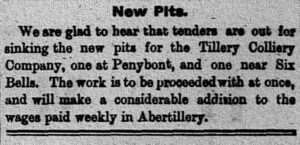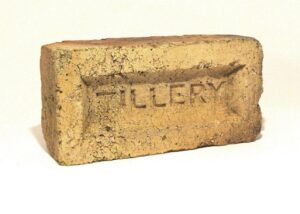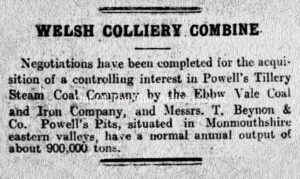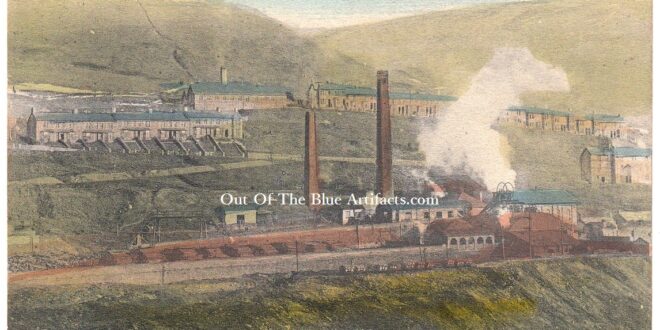The Vivian Colliery a Brief History.
 The Sinking of the Vivian and the Gray Collieries 1889.
The Sinking of the Vivian and the Gray Collieries 1889.
The Vivian and the Gray Collieries were sunk at the same time under the directorship of the owners Powell’s Tillery Colliery Company. Tenders were invited for the sinking in January 1889.
The Cutting of the Sod Ceremony.
On Tuesday 19th of February 1889, the ceremony of “Cutting the Sod” took place at both collieries. At 10.00am a special train with several spacious saloon carriages was laid on for the dignitaries which travelled from Cardiff to Newport and then shunted through Newport up the western valley to Abertillery Railway Station, they then made their way and gathered at the site of the proposed Gray Colliery. The group chosen to cut the sod of the new collieries were led by Mr John Hacquoil the Cardiff agent for Powell’s Tillery Colliery Co on behalf of Mr T. W. Powell who regretted not being there as he was in Australia, also present were Mr Dawson the company manager and Mr E. C. P. Hull a director of the company who accompanied the ladies in the party.
The Placing of the Gold Nuggets.
A brief address was given by Mr Dawson and the honour of cutting the first sod was given to Miss Hacquoil, Mr Hacquoil, Miss Alice Hacquoil, Miss Dawson, Mr Dawson and Mr Hull cut the others on that site. The group later submitted themselves and posed for many photographs. They then proceeded to the Vivian Colliery where the same procedure went through and the cutting of that sod on the marked-out area was given to the ladies again. Afterwards the Rev Mr Walters added a few words of congratulations and formally named the two collieries the “Vivian and the Gray”. During the cutting of the sod pieces of gold was placed in the holes from where the sod came out, this was done as a gift to the pit sinkers and crews.
The Sinking Contractors.
The sinking of the collieries was in the capable hands of Mr F. Coulson (Durham) and Mr Joseph Briggs (Head Sinker).
The party went back into town to the Tillery Reading Rooms for lunch, then all made their way back to Cardiff.
The Water Inrush.
In November 1889, the Vivian Colliery sinking was put on standstill through the influx of water. The sinkers were to widen the shaft that had already been sunk to aid the pumping of water from the shaft. The sinking teams had previously been put to work at the Penybont Colliery as the management wanted to keep the sinking teams together.
The Vivian Colliery Sinking Tragedy of 1890.
On Monday 7th December 1890 three pit sinkers were killed whilst engaged in the sinking of the Vivian Colliery. As mentioned, the firing was conducted by means of an electric blasting machine, the cartridges being ignited by the electric battery from the surface. At half past five on the morning of the accident nine sumping holes were fired by the charge men. The day gang went down half an hour later and proceeded to clear away the debris, this clearing went on until one o’clock in the afternoon when for no apparent reason a terrific explosion occurred. The inquiry stated that one cartridge may have not fired in the initial blasting and exploded later when the workmen accidentally hit it with their tools.
The Vivian Colliery Sinking Teams.
The Vivian Colliery Sinking Teams consisted of the following gentlemen – Contractor Mr F. Gleeson; Mr Joseph Briggs (Master Sinker); Mr James Gibbon (Assistant); Mr James Bannister – Bridge Street, Abertillery; Mr Thomas Rees – Panty-pwdyn, Abertillery; Mr George Millard – Cross Street, Abertillery; Mr Matthew Clark – Panty-pwdyn, Abertillery; Mr Henry Jordan – Bridge Street, Abertillery; Mr James Fear – Carmel Street, Abertillery; Mr Jacob Kyle – Panty-pwdyn, Abertillery; Mr James Johnston – Tillery Street, Abertillery:
Mr James Bannister, Mr Thomas Rees and Mr George Millard were killed, the rest were injured. Mr James Fear was unscathed.
On Saturday 16th May 1891, the Vivian and Gray Colliery sinkers held a testimonial in the Railway Inn, Abertillery for Mr John Burgess the organiser of the fund for the widows and children of the sinkers who had lost their lives in the tragedy of December 1890 during the sinking of the Vivian Pit. The sinkers who presented the gift to Mr John Burgess were – Mr Joseph Briggs (Head Sinker); Mr Johnson Briggs; Mr Thomas Carney; Mr Matthew Clarke and James Powell:
After the sinking of the Vivian Colliery began in 1889, it was said that the first coal was wound in the early 1890’s.
The Early Workforce.
Below are some of the men listed as working at the Vivian Colliery, Abertillery in the early years.
Mr Charles Stainer.
Mr Stainer, a native of Shaftsbury, Dorset, was a farm labour, he came to Abertillery with his wife and family in 1889 and began working for the Powell’s Tillery Colliery Company. On the 1891 census the Stainer family was listed as being at 5 Green Villas, Penybont, a short while later they moved to 9 James Terrace, Abertillery. Mr Stainer was the banksman at the Vivian Colliery and was said to have landed the first ever dram of coal at the Vivian Colliery.
Banksmen and Hitchers.
A banksman’s job was to put empty drams, men and materials on the cage to descend the shaft and to take off full drams and men, on ascent. They worked in unison with the hitchers at pit-bottom and the winding men, the three had total control of the signals and operations in the shaft at all times. They were called a banksmen as the top of the shaft was known as the bank. The men who worked on pit bottom, did a similar job, taking off empty drams and putting full ones on the cage etc, although they were called hitchers.
The Death of Mr and Mrs Stainer.
On Friday 23rd of October 1931, the South Wales Gazette reported on the deaths of Mr and Mrs Stainer at 9 James Terrace. They had died within forty-eight hours of each other. It was stated that Mrs Stainer had passed away on the 14th of October and Mr Stainer passed away on the 16th of October. They were both 84 years of age and had been married for 64 years, Mr Stainer had worked up to the age of 72.
Mr Albert Edwin Holbrook.
Mr Albert Edwin Holbrook was from Somerset, in his youth became an engineer and was engaged on the building of the Severn Railway Bridge in the 1870’s which he did all his work from a diving-bell. He later worked on erecting Cleopatra’s Needle on the Thames Embankment. At one time a pleasure steamer sank on the River Thames and he was the diver employed on the salvage work.
Mr Holbrook then went on to work on driving the Severn Tunnel in the late 1870’s – 1880’s. In later years he showed great knowledge in the South Wales Coalfield and became one of the top pit contractors in the Western Valley’s. He lived in Cromwell Street, Abertillery was engaged in sinking operations in many of the pits, he deepened the Rose Heyworth Colliery to the deeper seams and drove the connection from the Gray to the Vivian Colliery for ventilation purposes.
Mr Albert Edwin Holbrook was a founding member – number 57 of the Liberal and Labour Club, Abertillery. Before he died in 1934 at the age of 78, Mr Holbrook lived at 38 Victoria Street, Blaenau Gwent.
(More names and information to come).
The Powell’s Tillery Steam Coal Company.
At some point in time, around the turn of the century the Powell’s Tillery Colliery Company was renamed as the Powell’s Tillery Steam Coal Company, though the former name was used in news reports until the take over by the Ebbw Vale Steel, Iron and Coal Company.
 The Tillery Brickworks.
The Tillery Brickworks.
In 1891 the Powell’s Tillery Colliery Company who owned the Vivian, Gray and the Penybont Collieries at Abertillery opened their own brickworks in the grounds of the Vivian Colliery close to the Castle Street, Vivian Street junction.
They produced their bricks from clay from the colliery. There were two different coloured bricks in production, a buff and also a dark red coloured version. Bricks from this works were used in the construction of the original Powell’s Tillery Institute on Division Street, Abertillery.
Through the early part of the 1900’s the colliery was owned by the Powell’s Tillery Steam Coal Company along with the Gray and Penybont Collieries. A drivage was driven from the Vivian Colliery to the Gray then onto the Penybont Tillery Colliery for ventilation purposes and the Gray Colliery became the up-cast shaft for the three pits.
A Busy Day.
On Friday 21st of November 1902, the South Wales Gazette reported on – A Busy Day at the Vivian Colliery – On the previous Friday the 14th of November 1902, a very busy day was experienced, with the result that there was an output which was said to have been almost impossible to exceed at any pit with the same capacity for winding, as the “cage” is only a single decker. At 7.15am, 630 workmen had been lowered into the mine, after which winding coal etc was carried on throughout the day. At the end of the shift, the checkweigher reported that the operations for the day showed that 1,265 tons of coal and 43 tons of clay had been raised. Clay was extracted from the colliery as well as coal, the clay was used in the production of their own bricks at the Tillery Brickworks in the Vivian Colliery grounds.
The Collieries Waste Disposal.
The Vivian Colliery waste from below ground was disposed of by tipping close to the colliery, like most pits, by forming waste tips. The Gray Colliery which was linked to the Vivian, was situated close to the Abertillery town center and had no means of disposing its waste, so both pit’s waste was conveyed through a drivage below ground to the Vivian Colliery, to the surface and disposed of close to the gas works by means of a tip locally known as “The Hogs Back”.
The Aerial Flight Ropeway.
In 1909, as waste from the collieries was getting harder to dispose of, the company constructed an aerial flight, a ropeway with buckets extending from the Vivian Colliery to the top of the Areal Mountain.
Ebbw Vale Steel Iron and Coal Co Ltd & T. Beynon and Co Ltd.
In May 1916, negotiations began to acquire the collieries belonging to the Powell’s Tillery Steam Coal Co Ltd by the Ebbw Vale Steel, Iron and Coal Co Ltd & T. Beynon and Co Ltd. The new directors consisted of Mr J. W. Beynon the head of T. Beynon and Co and the director of the Ebbw Vale Company; Mr Frederick Mills the managing director; Sir Henry Mather Jackson-Bart and Major John Charters Kirk.
The Powell’s Tillery Steam Coal Company Ltd had a share capital of £144,006 and a debenture issue of £65,200, The collieries output was about 900,000 tons annually, total value was over half a million sterling. The Powell’s Tillery Company directors were – Col H. A. Powell; Messrs E. Heseltine; William Newall; W. J. Roch; and William Stewart (Managing Director); would retire. The Ebbw Vale Co were to take over the management of these collieries.
 The Ebbw Vale Company Takeover.
The Ebbw Vale Company Takeover.
On Friday 30th of June 1916, the collieries belonging to the Powell’s Tillery Steam Coal Co Ltd were finally acquired by the Ebbw Vale Steel, Iron and Coal Co Ltd & T. Beynon and Co Ltd (as seen left). The new directors consisted of Mr J. W. Beynon the head of T. Beynon and Co and the director of the Ebbw Vale Company; Mr Frederick Mills (Managing Director); Sir Henry Mather Jackson-Bart; and Major John Charters Kirk.
The Miners Lockout.
After the 1921 Miners Lockout, the Vivian Colliery never fully recovered and was closed. The colliery did not reopened until 1929.
The New Ventilation Fan.
In 1923 a new fan was installed at the Gray Colliery to improve the ventilation of the collieries.
The Vivian Colliery Reopening.
On Wednesday 30th of January 1929, the Western Daily Press reported on the reopening of the Penybont Colliery at Abertillery which was linked to the Vivian Colliery. The report states that on the previous day, Tuesday 29th of January 1929, the Penybont Colliery had reopened and the conditions were very good, this gave hope that the Vivain Colliery, which had been closed since 1921, would be reopened within the next month.
The New Ventilation Drift.
In August 1929 a new drift was driven from the Gray Colliery to aid in ventilation of the collieries.
The 1931 Stoppage.
In 1931 the Vivian Colliery stopped producing coal and remained idle for six years.
Mr David McLeod Carey M.E.
When the Vivian Colliery re-opened in June 1937 after six years closure, Mr David McLeod Carey M.E., became manager at the collier. Mr Carey was the son of Captain McLeod Carey the Chief Inspector of Mines for South Wales and Monmouthshire.
Messrs Partridge Jones and John Paton Ltd.
In July 1937 it was reported that the Vivian Colliery had re-opened after six years and had recently been taken over by the Messrs Partridge Jones and John Paton Ltd. It was announced that the new Manager was Mr David Carey (Celynen Collieries, Newbridge), the son of Captain J. Carey, H. M. Inspector of Mines.
Mr Arthur Hale.
In February 1938 Mr Arthur Hale of Newbridge formerly an official at Six Bells took over as manager.
The Colliery Bathing Facilities.
The miners from the Vivian Colliery had to use the Six Bells Colliery pithead baths and would walk from the Vivian to the Arrael Griffin Colliery on a daily basis. The route they had to take was becoming increasingly dangerous. In February 1954 a deputation from the Vivian Colliery was received at the Abertillery Council Chambers to hear their grievances, they tried to get the council to carry out repairs to the road.
The miners had previously approached the National Coal Board and British Railways to carry out repairs though both had stated that the road in question was not their property. Until the pithead baths had been built only a handful of people had ever used the road, though since its construction in 1953 between three to four-hundred men walked its route to bathe at the Arrael Griffin every day and night. The council said it was not their responsibility as the land and road was privately owned though stated that they would help and would arrange a meeting between the vice-chairman of the Abertillery Council, the chairman and vice-chairman of the Roads and Bridges Committee and the Six Bells ward members should be councils’ representatives at a meeting to be arranged between the N.C.B. and the owner of the said property.
Presentation of the Long Service Certificates.
In July 1952 a special function was held at the Bush Hotel, Abertillery to present Long Service Certificates (for over fifty years’ service) to twenty-six past and present workmen of the Vivian Colliery, who combined, had over one thousand years’ service to the mining industry.
Those present at the ceremony were – Mr G. H. Simpson M.B.E. (Agent for the Group); Mr Bryn Jenkins (Miners Agent and Councillor and Mr W. H. Hillman J.P., (Chairman of the Abertillery Council) who himself had given fifty-seven years’ service to the mining industry:
The proceedings were opened by Mr T. H. Wallace Manager of the Vivian Colliery who paid tribute to the miners present. Special attention was drawn to three of the veterans who between them had a total of 187 years service to the industry and were still working at the Vivian Colliery during the time of the presentations. They were – Mr W. E. Harris, who had spent 64 years service in the industry; Mr Tom Hopkins, who had worked over 62 years at the Vivian Colliery alone and Mr Gwilym Ace, (Chairman of the Vivian Lodge) with 61 years service to his credit. One of the veterans who was unable to attend was Mr Fred Talbot, aged seventy-two, who had 60 years service behind him. Mr Talbot started work underground at the Penybont Colliery aged twelve as a door-boy.
The workmen presented with Long Service Certificates were as follows – Mr W. E. Harris; Mr T. Hopkins; Mr G. Ace; Mr A. Harris; Mr J. Batten; Mr S. Edwards; Mr F. Talbot; Mr G. Newport; Mr F. Young; Mr A. Robins; Mr J. Parry; Mr T. Llewellyn; Mr W. J. Price; Mr M. Blacker; Mr H. Wilcox; Mr S. Griffiths; Mr E. James; Mr W. Mitchel; Mr T. Jones; Mr T. Screen; Mr W. Davies; Mr D. Davies; Mr E. Jones; Mr T. Price; Mr W. Price; Mr R. Evans and Mr W. Britton:
Throughout its fairly short history, the Vivian Colliery, Abertillery was closed and re-opened on many occasions, partly due to lack of trade, disputes and other difficulties. The colliery stopped producing coal sometime in the mid to late 1950’s.
The Six Bells Vivian Integration.
On Saturday 19th of July 1958, the South Wales Gazette reported that the Vivian Colliery was to be integrated into the Arrael Griffin, Six Bells Colliery.
The Closure of the Vivian Colliery.
The Vivian Colliery, Abertillery closed in 1961.
The Collieries Waste Disposal.
The Vivian Colliery waste from below ground was disposed of by tipping close to the colliery, like most pits, by forming waste tips. The Gray Colliery which was linked to the Vivian, was situated close to the Abertillery town center and had no means of disposing its waste, so both pit’s waste was conveyed through a drivage below ground to the Vivian Colliery, to the surface and disposed of close to the gas works by means of a tip locally known as “The Hogs Back” and also to the top of the Arael Mountain by way of an aerial flight. The Hogs Back tip was removed in the early 1970’s prior to the new Abertillery Sports Centre and Swimming Baths being constructed.
The Later Years.
The old Vivian Colliery site was cleared and in 1972-73 the Abertillery Sports Centre was constructed on a section of the old colliery site. Later a children’s skate-board park was constructed on the lower part of the colliery grounds, south of the sports centre.
The area of the old Hogs Back waste tip was later taken by a car sales, and electrical company known as L.C.R. and later still it was landscaped and used as a water settling treatment plant.
The Closure of the Sports Centre.
In about 2003 the Abertillery Sports Centre was closed and a new sports centre was constructed at Tillery Street, Abertillery.
The Demolition of the old Sports Centre.
In March 2019 the old sports centre on the Vivian Colliery site was demolished and the area was cleared.
Residential Housing.
In October 2023, the Blaenau Gwent County Borough Council received a planning application for residential development, including the erection of 22 houses, access, engineering and associated works.
(More information to come)
 Out Of The Blue Artifacts A Library of a lifetime of collecting
Out Of The Blue Artifacts A Library of a lifetime of collecting
